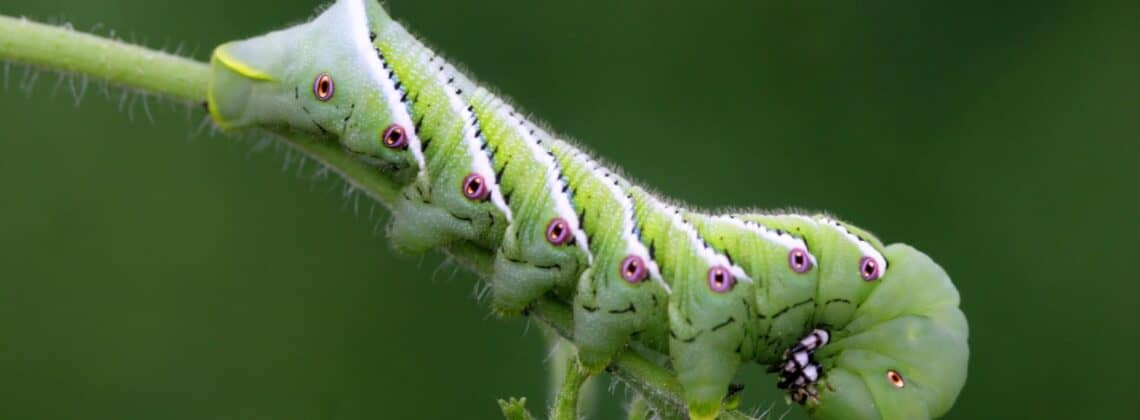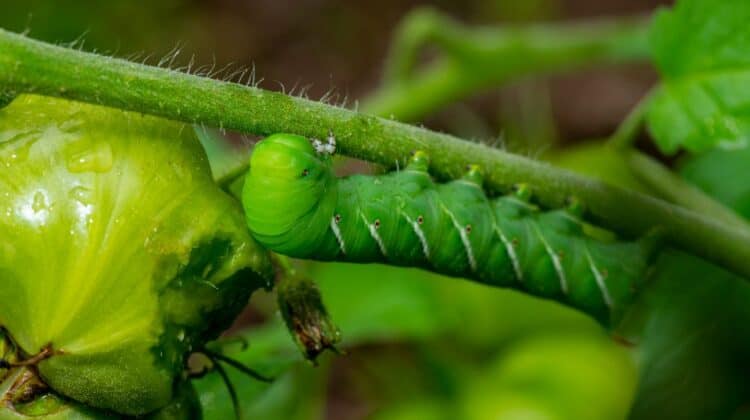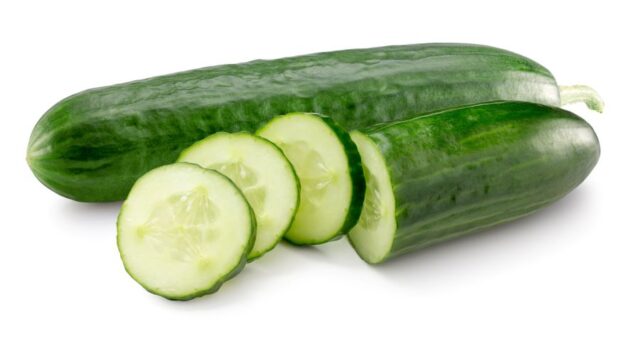
Here’s how to protect your tomato plants from tomato hornworm and other pests for tomatoes.
Tomatoes are a beloved crop for many home gardeners, prized for their juicy fruits and culinary versatility. In fact, tomatoes are the number one most popular plant in backyard vegetable gardens.
Growing tomatoes can be extremely rewarding. That’s because a homegrown, vine-ripened tomato is delicious and nutritious. Unfortunately, growing tomato plants can be challenging due to a variety of pests that threaten the health of the plants and the quality of the fruits.
Enemy number one for tomato plant damage is the dreaded tomato hornworm. A tomato hornworm is actually the caterpillar stage of a hawk moth (Manduca quinquemaculata), which is also known as a sphinx moth or a hummingbird moth.
Tomato hornworms are voracious eaters of tomato plant foliage. A hungry tomato hornworm can strip the leaves from a small tomato plant overnight. (They are most active from dusk until dawn.) So, keeping your tomato plants free from hungry tomato hornworms is a must. Keep reading for more information about tomato hornworm and other pests for tomatoes!
Identifying Tomato Hornworms
Tomato hornworms are large, bright green caterpillars that can grow up to 4 inches long. They have white diagonal stripes along their sides and a distinctive horn-like projection at their rear, which gives them their name. Despite their large size, hornworms can be difficult to spot due to their green coloration, which blends with tomato foliage.
These pests are voracious eaters and can defoliate a mature tomato plant in a matter of days, leaving behind only stems and large holes in any remaining leaves. They also feed on the fruits, leaving unsightly scars and making the tomatoes unappealing.

How to Get Rid of Tomato Hornworms
The best way to get of tomato hornworms is to manually pick them off your tomato plants. Put on a pair of garden gloves and start examining your tomato plants (and other plants in the nightshade family such as peppers, eggplants, and potatoes) for the large green and white-striped caterpillars. Hand-pick them from your plants and drown them in soapy water. You can also crush them or feed them to chickens.
You can also spray tomato hornworms with insecticidal soap or chemical insecticides, but I don’t recommend that. Insecticidal soap probably won’t kill the larger hornworms, and chemical insecticides leave residues on the tomatoes.
If you identify the tomato hornworms when they are small, you can spray your plants with Bacillus thuringiensis (Bt). Bacillus thuringiensis is a naturally occurring bacteria that kills caterpillars by invading their digestive systems. For best results, spray your tomato plants with Bt spray every 10–14 days throughout the garden season.
Beyond Tomato Hornworm and Other Pests for Tomatoes
In addition to the tomato hornworm, several other pests can damage your tomato plants.
- Aphids: These tiny, pear-shaped insects are often found in clusters on the undersides of leaves or on new growth. They can be green, black, brown, or red, and they feed by sucking the sap from plants. Aphid infestations can cause leaves to curl, yellow, and stunt plant growth. Spraying infected plants with a strong stream of water is often enough to control aphids.
- Whiteflies: Small, white, moth-like insects that congregate on the undersides of leaves. When disturbed, they flutter around in a cloud. Whiteflies feed on plant sap and can cause yellowing, wilting, and reduced vigor in tomato plants.
- Spider Mites: These tiny, spider-like pests are often found on the undersides of leaves, where they spin fine webs. Spider mites suck the sap from the leaves, causing them to turn yellow, dry out, and eventually drop off.
- Cutworms: These larvae of certain moth species are gray or brown and typically active at night. They chew through the stems of young tomato plants at or near the soil line, often killing the plant.
- Flea Beetles: These small, black or brown beetles jump like fleas when disturbed. They chew small, round holes in the leaves, giving them a “shotgun” appearance. Flea beetle damage can stunt plant growth and reduce yields.

Managing Tomato Pests
Managing most tomato pests requires a combination of cultural, mechanical, and chemical control methods. Here are some strategies to help protect your tomato plants:
- Handpicking: For large pests like tomato hornworms and cutworms, handpicking is an effective method. Wear gloves and remove the pests from the plants, then drop them into a bucket of soapy water to kill them. Regular inspection of your plants is key to catching these pests before they cause significant damage.
- Natural Predators: Encourage natural predators like ladybugs, lacewings, and parasitic wasps in your garden. These beneficial insects can help control aphids, whiteflies, and other small pests. Planting flowers such as marigolds, dill, and fennel can attract these beneficial insects to your garden.
- Insecticidal Soaps and Horticultural Oil: For aphids, whiteflies, and spider mites, insecticidal soaps and horticultural oils can be effective. These products work by smothering the pests and are less harmful to beneficial insects than traditional chemical insecticides. My favorite horticultural oil is Summit Year-Round Spray Oil because it’s certified organic. Be sure to follow the label instructions for safe and effective use.
- Row Covers: Using floating row covers can protect young plants from flea beetles and other pests. These covers act as a physical barrier, preventing insects from reaching the plants while still allowing light, air, and water to penetrate.
- Crop Rotation and Sanitation: Practice crop rotation by planting tomatoes in a different area of the garden each year to reduce the buildup of soil-borne pests such as cutworms. Additionally, remove and dispose of any plant debris at the end of the growing season to eliminate overwintering sites for pests.
- Chemical Control: If pest populations become overwhelming, chemical insecticides may be necessary. Choose products labeled for use on tomatoes and follow all safety precautions. Bacillus thuringiensis (Bt) is a biological insecticide that targets caterpillars such as tomato hornworms without harming beneficial insects.
Final Thoughts
By learning to identify common tomato pests and employing a combination of control methods, you can protect your plants and enjoy a bountiful harvest. Regular monitoring and early intervention are key to keeping your tomato plants healthy and productive throughout the growing season.
Now that you know about tomato hornworm and other pests of tomatoes, enjoy your homegrown tomatoes!




Leave a Reply